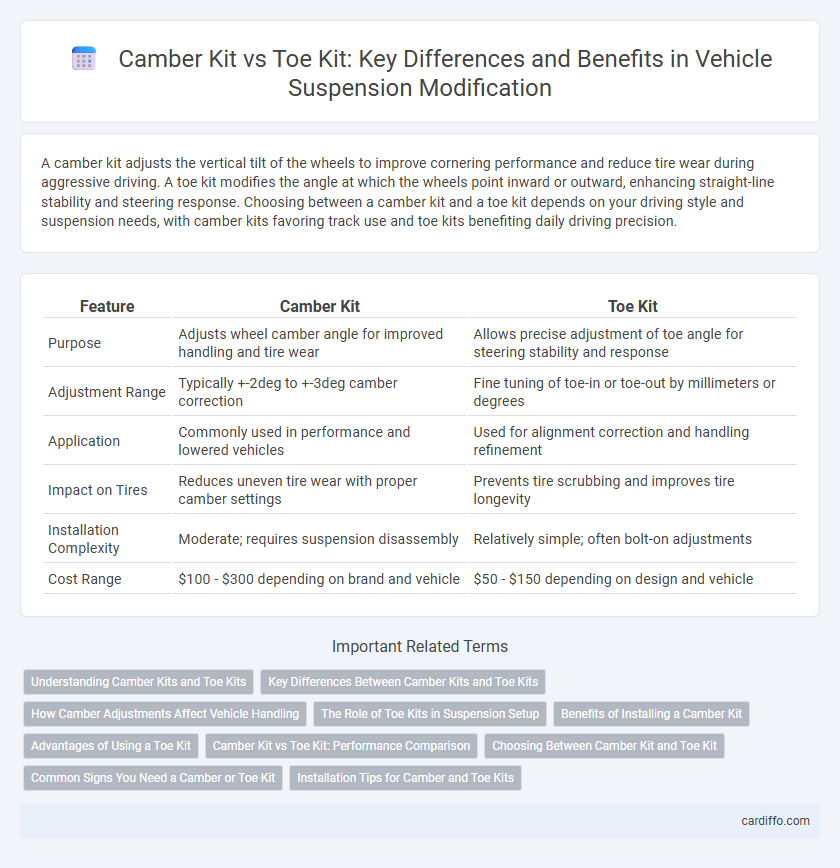A camber kit adjusts the vertical tilt of the wheels to improve cornering performance and reduce tire wear during aggressive driving. A toe kit modifies the angle at which the wheels point inward or outward, enhancing straight-line stability and steering response. Choosing between a camber kit and a toe kit depends on your driving style and suspension needs, with camber kits favoring track use and toe kits benefiting daily driving precision.
Table of Comparison
| Feature | Camber Kit | Toe Kit |
|---|---|---|
| Purpose | Adjusts wheel camber angle for improved handling and tire wear | Allows precise adjustment of toe angle for steering stability and response |
| Adjustment Range | Typically +-2deg to +-3deg camber correction | Fine tuning of toe-in or toe-out by millimeters or degrees |
| Application | Commonly used in performance and lowered vehicles | Used for alignment correction and handling refinement |
| Impact on Tires | Reduces uneven tire wear with proper camber settings | Prevents tire scrubbing and improves tire longevity |
| Installation Complexity | Moderate; requires suspension disassembly | Relatively simple; often bolt-on adjustments |
| Cost Range | $100 - $300 depending on brand and vehicle | $50 - $150 depending on design and vehicle |
Understanding Camber Kits and Toe Kits
Camber kits and toe kits are essential suspension modifications that significantly influence vehicle handling and tire wear. Camber kits adjust the vertical angle of the wheels, optimizing tire contact with the road for better cornering and stability, especially in performance driving. Toe kits fine-tune the horizontal alignment of the wheels, ensuring precise steering response and reducing uneven tire wear, which is crucial for maintaining optimal traction and safety.
Key Differences Between Camber Kits and Toe Kits
Camber kits primarily adjust the vertical tilt of the wheels, improving handling and tire wear by optimizing the contact patch during cornering. Toe kits modify the horizontal angle of the wheels, influencing steering response and stability, crucial for precise alignment settings. Understanding these key differences helps in selecting the correct suspension upgrade based on performance goals and vehicle dynamics.
How Camber Adjustments Affect Vehicle Handling
Camber adjustments influence vehicle handling by altering the angle of the wheels relative to the road surface, which directly impacts tire contact patch and grip during cornering. A camber kit enables precise tuning of the wheel camber, improving stability and responsiveness in high-performance or off-road driving conditions. Unlike toe kits that primarily adjust wheel alignment to correct steering and tire wear, camber kits enhance lateral traction and reduce understeer or oversteer tendencies by optimizing tire contact angles.
The Role of Toe Kits in Suspension Setup
Toe kits play a critical role in suspension setup by enabling precise adjustment of the wheel's angle relative to the vehicle's centerline, which directly influences handling, tire wear, and overall vehicle stability. Unlike camber kits that alter the vertical tilt of the wheels, toe kits fine-tune the alignment for improved cornering response and straight-line tracking. Proper toe adjustment enhances performance by reducing tire scrub and optimizing contact patches, essential for both daily driving and high-performance applications.
Benefits of Installing a Camber Kit
Installing a camber kit enhances vehicle handling and tire wear by allowing precise adjustment of the wheel's camber angle, which improves grip and cornering stability. This modification corrects alignment issues caused by lowered suspension or worn components, leading to increased tire lifespan and better road contact. Compared to a toe kit, a camber kit directly influences lateral tire position, offering more significant benefits for performance driving and suspension tuning.
Advantages of Using a Toe Kit
Using a toe kit offers precise alignment adjustments that improve tire wear and handling performance, particularly during high-speed cornering. Unlike camber kits, toe kits enable fine-tuning of the steering response and vehicle stability without significantly altering the suspension geometry. This results in enhanced tire longevity and optimized traction, making toe kits essential for performance driving and everyday road use.
Camber Kit vs Toe Kit: Performance Comparison
Camber kits and toe kits serve distinct purposes in vehicle suspension tuning, with camber kits primarily adjusting the wheel's vertical tilt for improved cornering grip and tire wear, while toe kits fine-tune the angle of the wheels relative to the vehicle's longitudinal axis, enhancing straight-line stability and steering responsiveness. Performance-wise, camber kits are favored in aggressive track or drift applications to maximize lateral traction, whereas toe kits are crucial for precise handling and minimizing tire scrub during acceleration and braking. Optimal suspension setup often involves a balance between camber and toe adjustments, tailored to driving style and track conditions.
Choosing Between Camber Kit and Toe Kit
Choosing between a camber kit and a toe kit depends on specific alignment goals and driving conditions. A camber kit primarily adjusts the vertical tilt of the wheels to improve cornering performance and reduce uneven tire wear. In contrast, a toe kit fine-tunes the angle of wheels relative to the vehicle's centerline, enhancing straight-line stability and tire longevity.
Common Signs You Need a Camber or Toe Kit
Uneven tire wear, such as excessive wear on the inner or outer edges, strongly indicates the need for a camber kit to correct wheel tilt. If your vehicle exhibits poor alignment, pulling to one side, or unstable steering, installing a toe kit can restore proper wheel positioning. Both kits enhance handling and tire lifespan by addressing specific suspension alignment issues common in performance and off-road modifications.
Installation Tips for Camber and Toe Kits
When installing camber and toe kits, precise alignment measurements are essential to ensure optimal vehicle handling and tire wear. Use high-quality torque wrenches to secure bolts to manufacturer specifications, preventing loosening under stress. Regularly recheck alignments after initial installation to accommodate suspension settling and maintain performance.
camber kit vs toe kit Infographic

 cardiffo.com
cardiffo.com